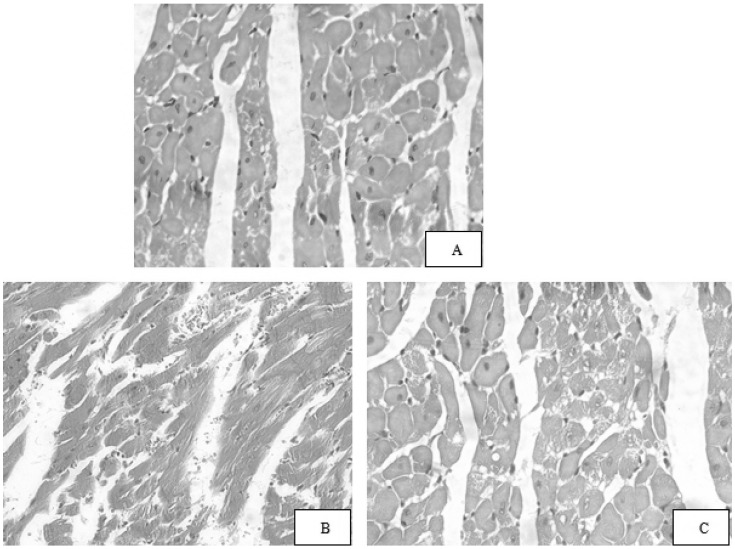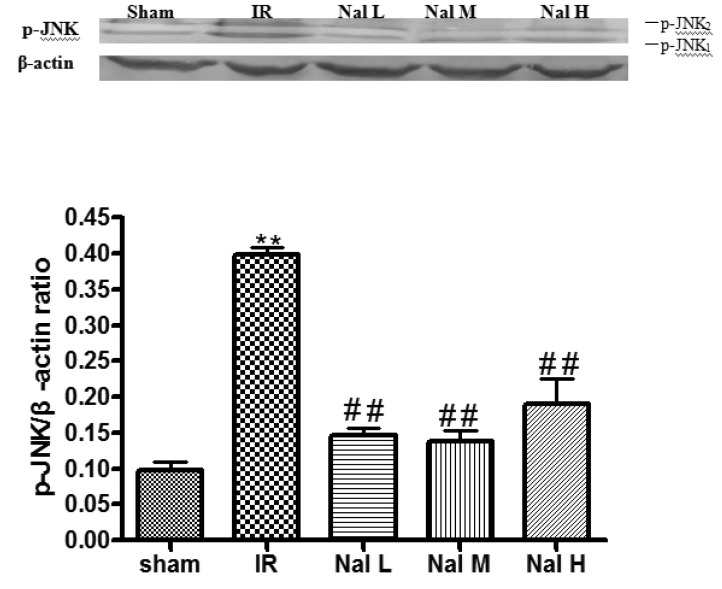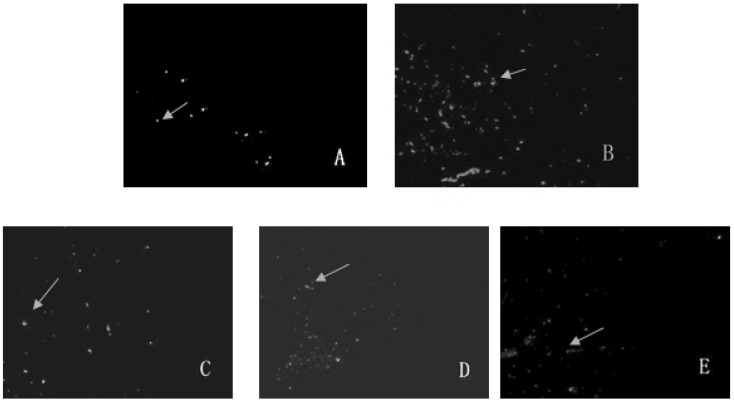Naloxone Postconditioning Alleviates Rat Myocardial Ischemia Reperfusion Injury by Inhibiting JNK Activity
- Affiliations
-
- 1Department of Pharmacology, Xuzhou Medical College, Xuzhou 221004, Jiangsu Province, China.
- 2Department of Cardiology, The People's Hospital of Suining, Suining 221200, Xuzhou, Jiangsu Province, China. xzd211xz@sina.com
- KMID: 2285493
- DOI: http://doi.org/10.4196/kjpp.2014.18.1.67
Abstract
- To investigate the alteration of c-Jun N-terminal kinase (JNK) activity after myocardial ischemia reperfusion injury (MIRI) and further explore the effect of naloxone postconditioning on MIRI. Forty male Sprague Dawley rats were randomly divided into five groups: sham operation (sham, n=8); ischemia reperfusion (IR, n=8); IR+naloxone 0.5 mg/kg (Nal L, n=8); IR+naloxone 1.0 mg/kg (Nal M, n=8); IR+naloxone 2.0 mg/kg (Nal H, n=8). Pathological changes of myocardial tissue were visualized by HE staining. The expression of p-JNK, and the apoptosis of cardiomyocytes were investigated with Western blotting and the TUNEL assay, respectively. Irregular arrangement and aberrant structure of myocardial fibers, cardiomyocytes with granular or vacuolar degeneration, and inflammatory cells infiltrating the myocardial interstitial regions characterized MIRI in the IR group. Signs of myocardial injury and inflammatory infiltration were less prominent in the Nal-treated groups. The expression of p-JNK in the sham group and in all Nal-treated groups was significantly lower than that in the IR group (p<0.01). The apoptosis index of cardiomyocytes in the IR group was significantly higher than in the sham group (p< 0.01). The apoptosis indices of cardiomyocytes in all Nal-treated groups were significantly reduced to 55.4%, 26.2%, and 27.6%, respectively, of the IR group (p< 0.01). This study revealed that Naloxone postconditioning before reperfusion inhibits p-JNK expression and decreases cell apoptosis, thus alleviating MIRI.
MeSH Terms
Figure
Cited by 3 articles
-
Preventive Effect of Polysaccharide of
Larimichthys crocea Swim Bladder on Reserpine Induced Gastric Ulcer in ICR Mice
Gui-Jie Li, Peng Sun, Rui Wang, Ya-Lin Zhou, Yu Qian, Xin Zhao
Korean J Physiol Pharmacol. 2014;18(2):183-190. doi: 10.4196/kjpp.2014.18.2.183.The Effects of Ischemic Postconditioning on Myocardial Function and Nitric Oxide Metabolites Following Ischemia-Reperfusion in Hyperthyroid Rats
Jalal Zaman, Sajjad Jeddi, Asghar Ghasemi
Korean J Physiol Pharmacol. 2014;18(6):481-487. doi: 10.4196/kjpp.2014.18.6.481.NecroX-5 protects mitochondrial oxidative phosphorylation capacity and preserves PGC1α expression levels during hypoxia/reoxygenation injury
Vu Thi Thu, Hyoung Kyu Kim, Le Thanh Long, Bayalagmaa Nyamaa, In-Sung Song, To Thanh Thuy, Nguyen Quang Huy, Jubert Marquez, Soon Ha Kim, Nari Kim, Kyung Soo Ko, Byoung Doo Rhee, Jin Han
Korean J Physiol Pharmacol. 2016;20(2):201-211. doi: 10.4196/kjpp.2016.20.2.201.
Reference
-
1. Sekikawa A, Horiuchi BY, Edmundowicz D, Ueshima H, Curb JD, Sutton-Tyrrell K, Okamura T, Kadowaki T, Kashiwagi A, Mitsunami K, Murata K, Nakamura Y, Rodriguez BL, Kuller LH. A "natural experiment" in cardiovascular epidemiology in the early 21st century. Heart. 2003; 89:255–257. PMID: 12591821.2. Zhao ZQ, Corvera JS, Halkos ME, Kerendi F, Wang NP, Guyton RA, Vinten-Johansen J. Inhibition of myocardial injury by ischemic postconditioning during reperfusion: comparison with ischemic preconditioning. Am J Physiol Heart Circ Physiol. 2003; 285:H579–H588. PMID: 12860564.
Article3. Zhu M, Feng J, Lucchinetti E, Fischer G, Xu L, Pedrazzini T, Schaub MC, Zaugg M. Ischemic postconditioning protects remodeled myocardium via the PI3K-PKB/Akt reperfusion injury salvage kinase pathway. Cardiovasc Res. 2006; 72:152–162. PMID: 16901477.
Article4. Zhang W, Miao Y, Zhou S, Jiang J, Luo Q, Qiu Y. Neuroprotective effects of ischemic postconditioning on global brain ischemia in rats through upregulation of hippocampal glutamine synthetase. J Clin Neurosci. 2011; 18:685–689. PMID: 21371894.
Article5. Penna C, Pasqua T, Perrelli MG, Pagliaro P, Cerra MC, Angelone T. Postconditioning with glucagon like peptide-2 reduces ischemia/reperfusion injury in isolated rat hearts: role of survival kinases and mitochondrial KATP channels. Basic Res Cardiol. 2012; 107:272. PMID: 22699364.
Article6. Glembotski CC, Thuerauf DJ, Huang C, Vekich JA, Gottlieb RA, Doroudgar S. Mesencephalic astrocyte-derived neurotrophic factor protects the heart from ischemic damage and is selectively secreted upon sarco/endoplasmic reticulum calcium depletion. J Biol Chem. 2012; 287:25893–25904. PMID: 22637475.
Article7. Chen S, Liu J, Liu X, Fu Y, Zhang M, Lin Q, Zhu J, Mai L, Shan Z, Yu X, Yang M, Lin S. Panax notoginseng saponins inhibit ischemia-induced apoptosis by activating PI3K/Akt pathway in cardiomyocytes. J Ethnopharmacol. 2011; 137:263–270. PMID: 21619920.
Article8. Liu Y, Liao X, Xue FS, Xu YC, Xiong J, Yuan YJ, Wang Q, Liu JH, Zhao JX. Effects of combined ischemic postconditioning, remote ischemic postconditioning and naloxone postconditioning on focal cerebral ischemia-reperfusion injury in rats. Zhonghua Yi Xue Za Zhi. 2011; 91:1493–1497. PMID: 21914288.9. Mutoh J, Ohsawa M, Hisa H. Effect of naloxone on ischemic acute kidney injury in the mouse. Neuropharmacology. 2013; 71:10–18. PMID: 23523991.
Article10. Zhang T, Zhou WD, Xia AZ, Gu SL. Effect of p38 MAPK on naloxone alleviating myocardial ischemia reperfusion injury in rats. West China J Pharm Sci. 2011; 26:460–462.11. Gottlieb RA, Burleson KO, Kloner RA, Babior BM, Engler RL. Reperfusion injury induces apoptosis in rabbit cardiomyocytes. J Clin Invest. 1994; 94:1621–1628. PMID: 7929838.
Article12. Ferrandi C, Ballerio R, Gaillard P, Giachetti C, Carboni S, Vitte PA, Gotteland JP, Cirillo R. Inhibition of c-Jun N-terminal kinase decreases cardiomyocyte apoptosis and infarct size after myocardial ischemia and reperfusion in anaesthetized rats. Br J Pharmacol. 2004; 142:953–960. PMID: 15210584.
Article13. Hori M, Nishida K. Oxidative stress and left ventricular remodelling after myocardial infarction. Cardiovasc Res. 2009; 81:457–464. PMID: 19047340.
Article14. Jiang CM, Xu CQ, Mi Y, Li HZ, Wang R, Li WM. Calcium-sensing receptor induced myocardial ischemia/reperfusion injury via the c-Jun NH2-terminal protein kinase pathway. Acta Cardiol Sin. 2010; 26:102–110.15. Matsumoto N, Imamura R, Suda T. Caspase-8- and JNK-dependent AP-1 activation is required for Fas ligand-induced IL-8 production. FEBS J. 2007; 274:2376–2384. PMID: 17403042.
Article16. Lee SE, Lim JW, Kim H. Activator protein-1 mediates docosahexaenoic acid-induced apoptosis of human gastric cancer cells. Ann N Y Acad Sci. 2009; 1171:163–169. PMID: 19723051.
Article17. Setoguchi D, Kakihana Y. Naloxone. Masui. 2013; 62:5–9. PMID: 23431888.18. Zhou P, Dong CL, Niu RX, Wu JX, Li YH. The effects of naloxone in free oxygen radical during myocardial ischemia-reperfusion period. J Med Res. 2008; 37:56–57.19. Qin YH, Shen H, Yang YS, Wen TB, Li TD. Naloxone inhibits generation of IL-8 and TXA2 from Ischemic and reperfused myocardium. Pharmaceutical J Chin People's Liberation Army. 2008; 24:23–25.20. Wong GT, Li R, Jiang LL, Irwin MG. Remifentanil postconditioning attenuates cardiac ischemia-reperfusion injury via kappa or delta opioid receptor activation. Acta Anaesthesiol Scand. 2010; 54:510–518. PMID: 19878098.
- Full Text Links
- Actions
-
Cited
- CITED
-
- Close
- Share
- Similar articles
-
- Ischemic Postconditioning Inhibits Mitochondrial Permeability Transition Pore via Opioid Receptor Activation in Intact Rat Heart
- Effects of postconditioning with N,N,N'N'-tetrakis-[2-pyridylmethyl]-ethylenediamine in isolated rat hearts
- Morphine-induced postconditioning modulates mitochondrial permeability transition pore opening via delta-1 opioid receptors activation in isolated rat hearts
- Ischemic postconditioning may not influence early brain injury induced by focal cerebral ischemia/reperfusion in rats
- Dexmedetomidine alleviates blood-brain barrier disruption in rats after cerebral ischemia-reperfusion by suppressing JNK and p38 MAPK signaling





